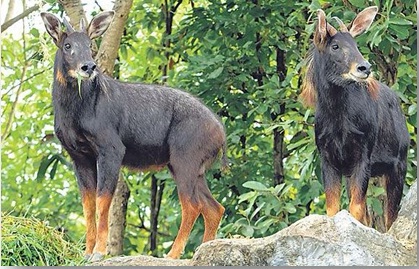

Context: Extinct Himalayan Serow spotted in Spiti Valley by team of wildlife experts.
 Background: The Himalayan Serow, till date was considerd to be extinct, spotted in the cold deserts of the Spiti valley in Himachal Pradesh. The re-occurance of the subspecies of the mainland serow was believed to be extinct, has excited environmentalists and wildlife experts in the region.
Background: The Himalayan Serow, till date was considerd to be extinct, spotted in the cold deserts of the Spiti valley in Himachal Pradesh. The re-occurance of the subspecies of the mainland serow was believed to be extinct, has excited environmentalists and wildlife experts in the region.
An official said it is an extremely shy animal, its habitat is dense forests and can only be sighted during winters, when it migrates to lower elevations.
Himalayan Serow
A biologist has decribed it as resembling a cross between a goat, a donkey, a cow, and a pig. It’s a medium-sized mammal with a large head, thick neck, short limbs, long, mule-like ears, and a coat of dark hair.
There are several species of serows, and all of them are found in Asia. The Himalayan serow, or Capricornis sumatraensis thar, is restricted to the Himalayan region. Taxonomically, it is a subspecies of the mainland serow (Capricornis sumatraensis).
Himalayan serows are herbivores, and are typically found at altitudes between 2,000 metres and 4,000 metres (6,500 to 13,000 feet). They are known to be found in eastern, central, and western Himalayas, but not in the Trans Himalayan region.
Habitat of Serows
The animal was spotted by locals and wildlife officials at a riverside rocky wall near Hurling village in Spiti, Himachal Pradesh, just recently. It was again sighted in the area, after two days.
This is the first recorded human sighting of the serow in Himachal Pradesh. The animal has been spotted a few times earlier in the state, but that has always been through camera traps.
Significance of Present Sight
Spiti lies in the cold mountain desert region of the western Himalaya, and its valley floor has an average elevation of 4,270 metres above sea level.
Serows are generally not found at this altitude, and never before has a serow been seen in the Himalayan cold desert. Wildlife officials believe this particular animal may have strayed into the Spiti valley from the Rupi Bhaba Wildlife Sanctuary in adjoining Kinnaur.
The Director of the Great Himalayan National Park in Kullu where serows have previously been spotted, said he was surprised that a serow had been photographed from close range. It is otherwise a very elusive animal, and few people have ever caught so much as a glimpse of it.
The National Park team have been frantically trying to spot serows in the national park for the last 10-12 years, and have so far managed only two sightings through camera traps in the Tirthan valley.
The animal has also been spotted in the Rupi Bhaba Wildlife Sanctuary, and in the higher reaches of Chamba.
IUCN Status
According to the International Union for Conservation of Nature (IUCN), Himalayan serows have experienced significant declines in population size, range size and habitat in the last decade, and this is expected to continue due to intensive human impact.
Previously assessed as ‘near threatened’, the Himalayan serow is now been categorised as ‘vulnerable’ in the IUCN Red List of Threatened Species.
It is listed under Schedule I of The Wildlife Protection Act, 1972, which provides was under absolute protection.
Conclusion
It is a good news for all, Himalayan serows are solitary by nature, and even though it has been sighted twice, it is “too clever” to be caught for rescue purposes. An appearance of a goat with long, donkey like ears, and a habit of standing with forelegs astraddle, make the Serow an ungainly goat antelope.
Connecting the Article
Question for Prelims : Rupi Bhaba Wildlife Sanctuary located in
(a) Himachal Pradesh
(b) Uttarakhand
(c) Sikkim
(d) Assam
Question for Mains : Discuss the impact of changing environmental conditions on the wildlife habitat. How wild animals can be protected from such changes.

Our support team will be happy to assist you!
